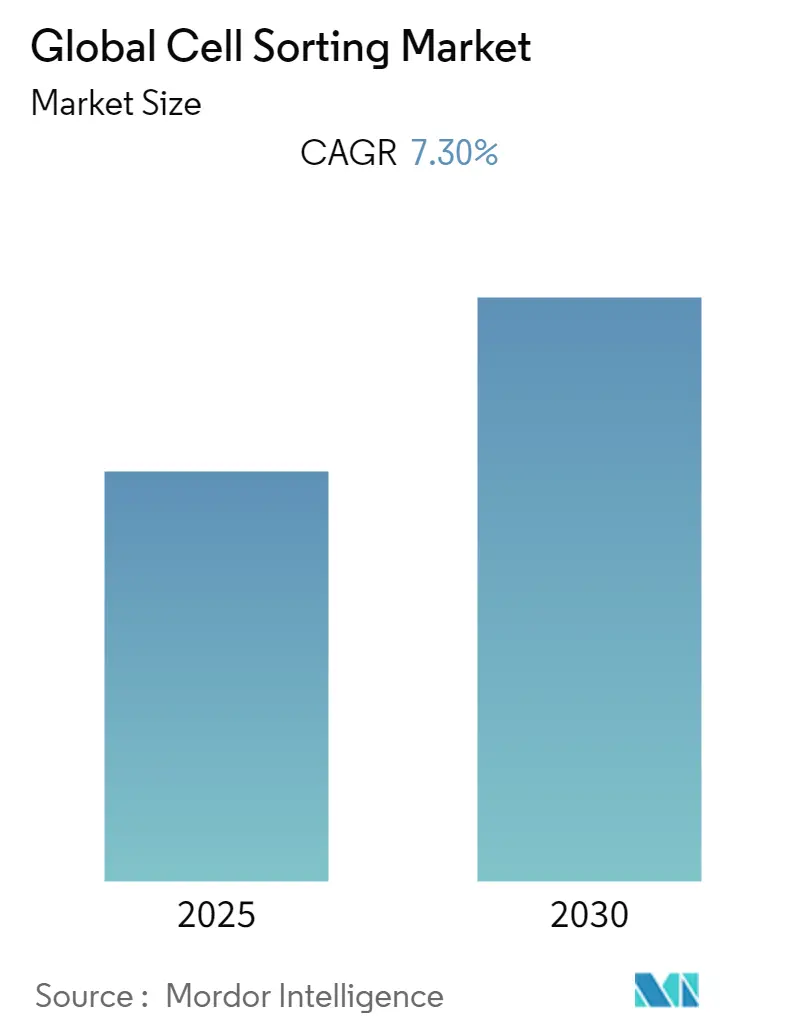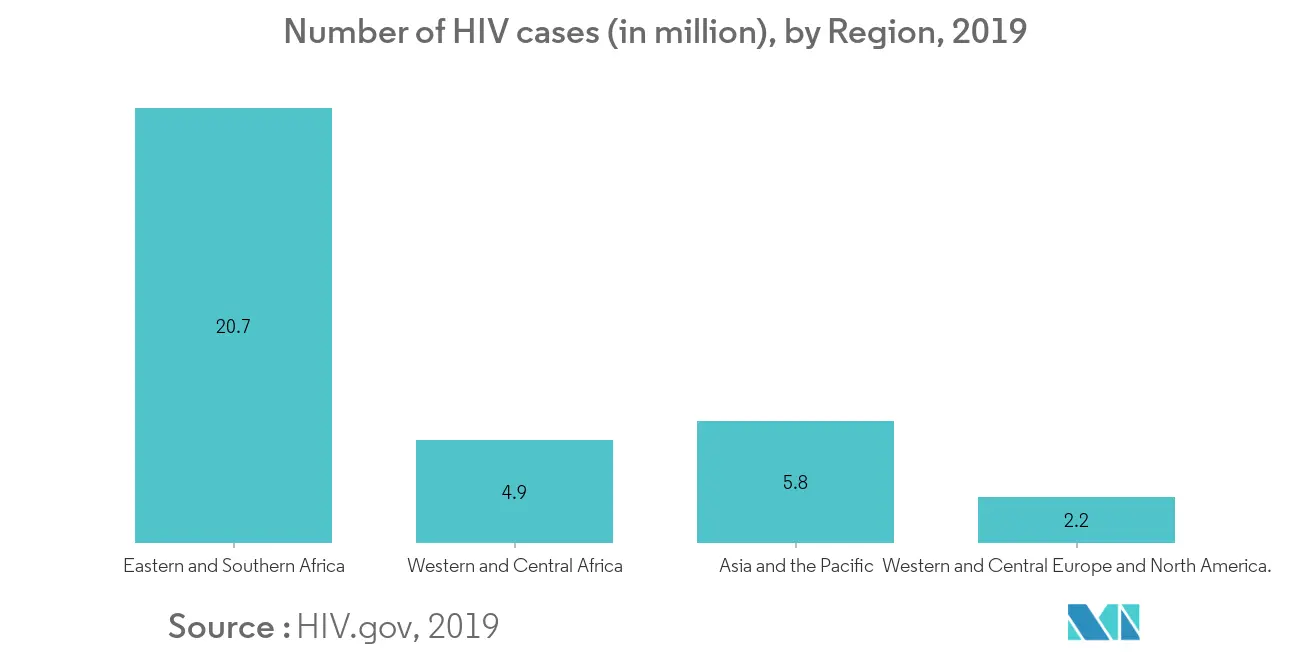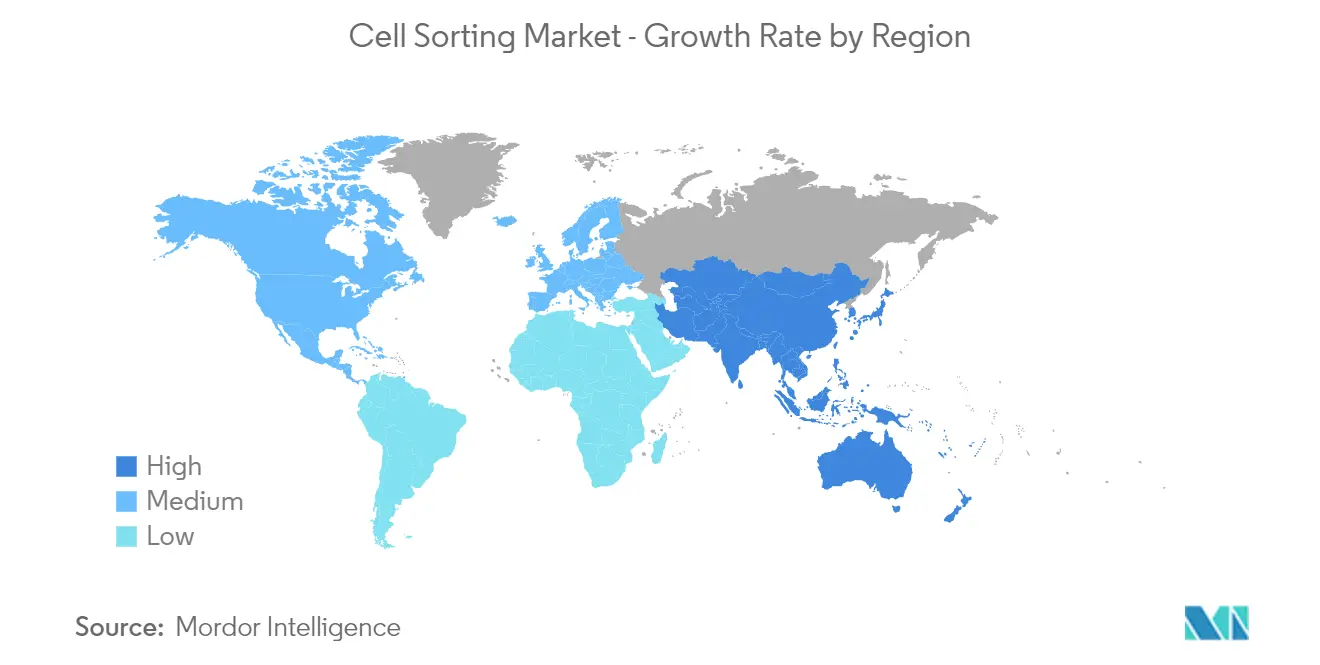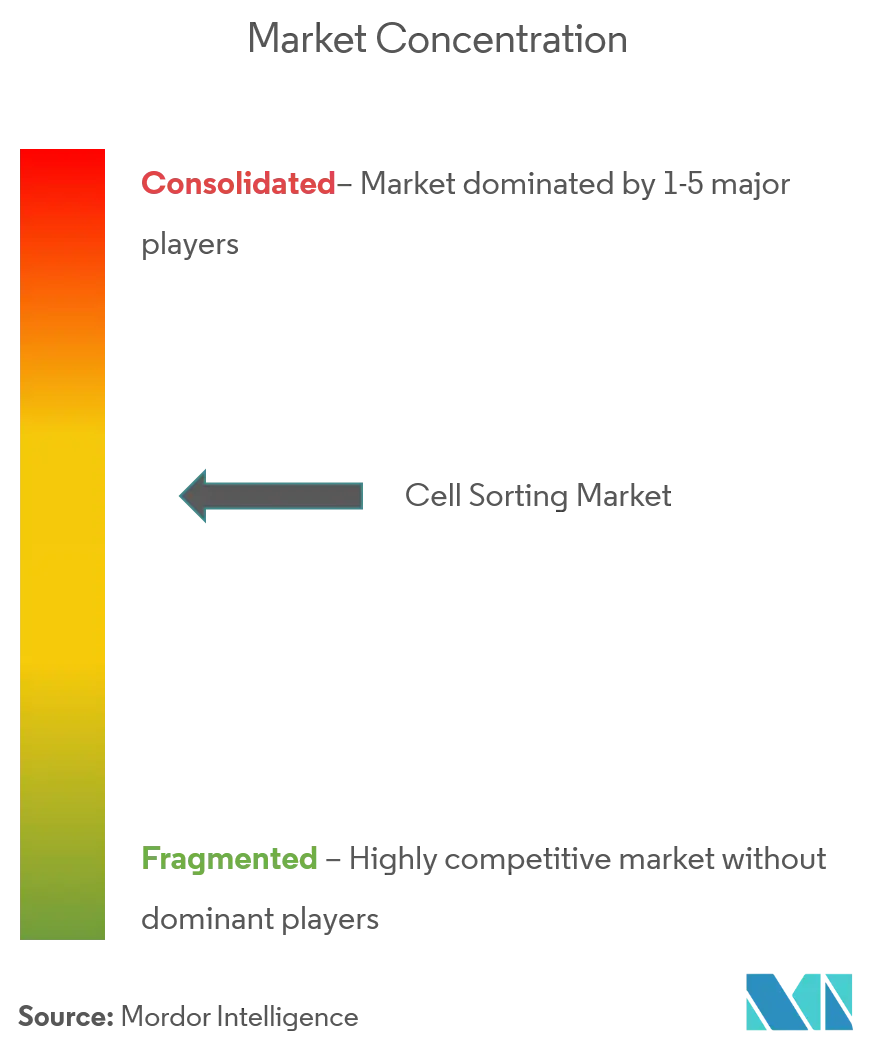Global Cell Sorting Market Size and Share

Global Cell Sorting Market Analysis by Mordor Intelligence
The Global Cell Sorting Market is expected to register a CAGR of 7.3% during the forecast period.
Due to the pandemic, all the research and development programs have been only for developing drugs and vaccines related to the coronavirus, and all other programs have come to a halt. Many biotech and pharma companies have stopped producing due to the lack of labor during the lockdown globally. The growing market has not been as expected due to the companies' disruption of research programs and less procurement of cell sorters.
The cell sorting market will show rapid growth due to the growing prevalence of HIV and cancer, expanding pharmaceutical and biotechnology industries, and technological advancements in cell sorters.
HIV continues to be a major global public health issue. The vast majority of people living with HIV are located in low- and middle-income countries. According to UnAIDs, 2020 estimates, around 38.0 million people globally had AIDS as of 2019. 1.7 million got newly infected.
Over the years, cell sorting was combined with molecular biological techniques and proteomics for characterizing metastatic and primary cancer cell populations and single tumor cells. According to Globocan, 19.29 million people got newly diagnosed with cancer for the year 2020. In 2020, an estimated 1,806,590 new cases of cancer were diagnosed in the United States, and 606,520 people died due to the disease as per National Cancer Institute. With the growing prevalence of cancer, the demand for cell sorters also increases for characterizing tumors.
However, the high cost of the devices and the lack of awareness of the advantages of these cell sorters restrain the market in the forecast period.
Global Cell Sorting Market Trends and Insights
Fluorescence-based Droplet Cell Sorting (FACS) is Expected to be the Largest Growing Segment in the Cell Sorting Market
The fluorescence-based droplet cell sorting segment is expected to grow during the forecast period due to it being a highly accurate and precise sorting method. It is essential in numerous biological assays requiring high-throughput analysis and sorting of single cells. The gold standard technology for this purpose is fluorescence-activated cell sorting (FACS).
It provides a method of filtering a mixture of living cells in two or more vessels, one cell at a time, based on light scattering light and fluorescent features of each cell. It is a useful scientific tool, as it provides a fast, purposeful, and balanced recording of fluorescent signals from individual cells as well as the body classification of specific cells of interest.
FACS is thus anticipated to be the segment driving the growth of the cell sorting market during the forecast period, owing to its accuracy and increasing applications. In addition, it offers higher purity and recovery of cells as compared to other methods, though the cells are lost due to mortality.
Moreover, the growing incidence of diseases like HIV and cancers is increasing the demand for these devices. The International Agency for Research on Cancer 2020 estimates that worldwide, one person in 5 develops cancer at some point in life, and 1 in 8 men and 1 in 11 women die from the disease. These new estimates showed that more than 50 million people live within five years of a previous cancer diagnosis for the year 2020. The number of older people worldwide and the economic and economic pressures remain among the factors contributing to this increase. The growing population of patients needing diagnosis is increasing the segment growth.

North America is Found Leading the Cell Sorting Market
North America has dominated the market due to the high investments in the pharmaceutical and biotechnology industries and the increasing adoption of this technique in cancer research, as well as the development of new therapeutics in countries such as the United States.
In addition, the rising incidence of cancer and other infectious diseases in the country drives regional growth. According to the Centers for Disease Control and Prevention, the number of visits to physician offices with infectious and parasitic diseases as the primary diagnosis was 15.5 million for the year 2018 in the country. The increasing rates of cancer and diseases that require cell sorting and the increasing healthcare expenditure in the country boost the market growth in the region.
The cell sorting market's growth in these regions can be attributed to advanced research infrastructures, significant health care spending, and increase government funding for research. According to Patented Medicine Prices Review Board - Annual Report 2018, the pharma expenditure in Canada increased from CAD 0.79 million in 2014 to CAD 0.89 million in 2018. The increase in fundings and the rising prevalence of chronic diseases boost the market growth in the region.

Competitive Landscape
There has been a presence of a considerable number of companies that are mainly focusing on agreements and expansions to strengthen their business operations. Key companies are engaged in significant strategic initiatives such as regional expansion, product development, and strategic collaborations and partnerships. Some of the major players are Becton, Dickinson and Company, Miltenyi Biotec GmbH, Bio-Rad Laboratories Inc., Beckman Coulter Inc. (Danaher Corporation), etc.
Global Cell Sorting Industry Leaders
-
Becton, Dickinson and Company
-
Beckman Coulter, Inc. (Danaher Corporation)
-
Bio-Rad Laboratories, Inc.
-
Sony Biotechnology Inc.
-
Miltenyi Biotec GmbH
- *Disclaimer: Major Players sorted in no particular order

Recent Industry Developments
- In June 2020, LevitasBio announced the launch of a technology that is magnetic levitation-based cell separation. The technology uses magnet-induced density gradients to spread out different types of cells and could be used, for example, to separate live cells from dead ones.
- In October 2020, PHC Corporation of North America announced the partnership with On-chip Biotechnologies (USA) Co. Ltd to drive delivery of total cell culturing solutions for researchers and organizations across a wide range of critical applications.
Global Cell Sorting Market Report Scope
As per the scope of the cell sorting market report, cell sorting is a technique employed for the separation of cells based on their intracellular and extracellular properties. The intracellular properties include properties such as DNA, RNA, and protein molecule interaction and extracellular properties consist of surface protein expression and morphology of the cell. The techniques of isolating and sorting different types of a cell have unlocked many applications in research and medicinal industry. The cell sorting market is segmented by technology (fluorescence-based droplet cell sorting, magnetic-activated cell sorting (MACS), and micro-electromechanical systems (MEMS)), product and service (cell sorters, cell sorting reagents and consumables, and cell sorting services), end user (research institutions, pharmaceutical and biotechnology companies, and other end users), and geography (North America, Europe, Asia-Pacific, Middle-East and Africa, and South America). The market report also covers the estimated market sizes and trends for 17 different countries across major regions globally. The report offers the value (in USD million) for the above segments.
| Fluorescence-based Droplet Cell Sorting |
| Magnetic-activated Cell Sorting (MACS) |
| Micro-electromechanical Systems (MEMS) - Microfluidics |
| Cell Sorters |
| Cell Sorting Reagents and Consumables |
| Cell Sorting Services |
| Research Institutions |
| Pharmaceutical and Biotechnology Companies |
| Other End Users |
| North America | United States |
| Canada | |
| Mexico | |
| Europe | Germany |
| United Kingdom | |
| France | |
| Italy | |
| Spain | |
| Rest of Europe | |
| Asia-Pacific | China |
| Japan | |
| India | |
| Australia | |
| South Korea | |
| Rest of Asia-Pacific | |
| Middle-East and Africa | GCC |
| South Africa | |
| Rest of Middle East and Africa | |
| South America | Brazil |
| Argentina | |
| Rest of South America |
| By Technology | Fluorescence-based Droplet Cell Sorting | |
| Magnetic-activated Cell Sorting (MACS) | ||
| Micro-electromechanical Systems (MEMS) - Microfluidics | ||
| By Product and Service | Cell Sorters | |
| Cell Sorting Reagents and Consumables | ||
| Cell Sorting Services | ||
| By End User | Research Institutions | |
| Pharmaceutical and Biotechnology Companies | ||
| Other End Users | ||
| By Geography | North America | United States |
| Canada | ||
| Mexico | ||
| Europe | Germany | |
| United Kingdom | ||
| France | ||
| Italy | ||
| Spain | ||
| Rest of Europe | ||
| Asia-Pacific | China | |
| Japan | ||
| India | ||
| Australia | ||
| South Korea | ||
| Rest of Asia-Pacific | ||
| Middle-East and Africa | GCC | |
| South Africa | ||
| Rest of Middle East and Africa | ||
| South America | Brazil | |
| Argentina | ||
| Rest of South America | ||
Key Questions Answered in the Report
What is the current Global Cell Sorting Market size?
The Global Cell Sorting Market is projected to register a CAGR of 7.3% during the forecast period (2025-2030)
Who are the key players in Global Cell Sorting Market?
Becton, Dickinson and Company, Beckman Coulter, Inc. (Danaher Corporation), Bio-Rad Laboratories, Inc., Sony Biotechnology Inc. and Miltenyi Biotec GmbH are the major companies operating in the Global Cell Sorting Market.
Which is the fastest growing region in Global Cell Sorting Market?
Asia Pacific is estimated to grow at the highest CAGR over the forecast period (2025-2030).
Which region has the biggest share in Global Cell Sorting Market?
In 2025, the North America accounts for the largest market share in Global Cell Sorting Market.
What years does this Global Cell Sorting Market cover?
The report covers the Global Cell Sorting Market historical market size for years: 2019, 2020, 2021, 2022, 2023 and 2024. The report also forecasts the Global Cell Sorting Market size for years: 2025, 2026, 2027, 2028, 2029 and 2030.
Page last updated on:
Global Cell Sorting Market Report
Statistics for the 2025 Global Cell Sorting market share, size and revenue growth rate, created by Mordor Intelligence™ Industry Reports. Global Cell Sorting analysis includes a market forecast outlook for 2025 to 2030 and historical overview. Get a sample of this industry analysis as a free report PDF download.
/cell-sorting-market--growth,-trends,-and-forecast-(2020-–-2025)_Picture5.webp)


